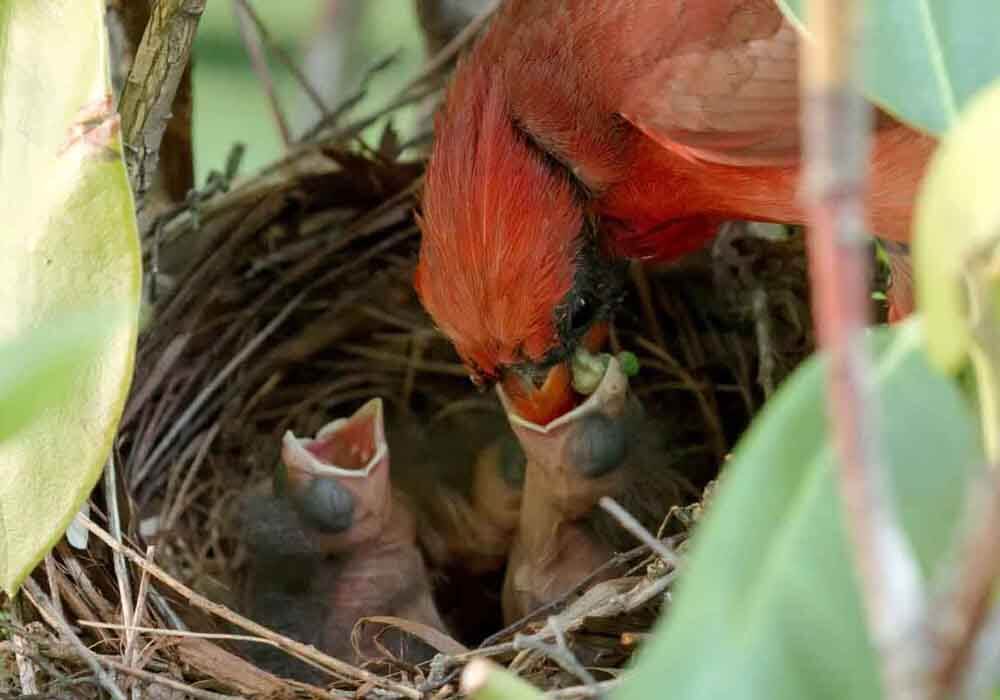Cardinal Nesting Habits and Season
The cardinal is a vast avian family of several species, including buntings, grosbeaks, seedeaters, etc. Related by molecular work and not physical attributes, cardinal nesting habits vary. Some are typical to other birds; others are unique & intriguing. So, what are the Cardinal nesting habits and season?
Cardinal nesting habits include nesting in branches or dense shrubs and monogamy. The parents work together by taking turns to incubate their young till they are independent. They may have also labored together to build the nest but will abandon it when each looks to raise a new brood.
The rest of this article will explain cardinal nesting habits, including their preferred period and location, how they build nests and all about their eggs. Keep reading to learn more.

When Is Cardinal Nesting Season and for How Long?
Like most birds, cardinals prepare for new offspring by nesting. Nesting ensures the survival and healthy growth of their brood when born. So, when is the cardinal nesting season, and how long does it last?
Cardinal nesting season lasts around three to eight months, but the period varies by species. For example, the Northern cardinal begins nest-building in late winter. They finally nest in March but can also raise other brood(s) till September. Hence, their nesting season lasts roughly 6-7 months.
A cardinal pair may mate for consecutive years till one partner dies or chooses another between seasons.
Here are some other famous cardinals and their nesting seasons:
- Red-breasted chat: They nest for four months between May and September
- Western Tanager: They nest for four months between mid-April to August.
- Evening Grosbeak: The evening grosbeak's nesting period begins in April up until early September. However, the pair may arrive at breeding grounds around late March.
- Indigo Bunting: These species mainly breed from June through August but can begin nest-building from May. The season will last four months in total.
- Dickcissel: The polygynous dickcissel reaches breeding grounds around May to early June. They nest throughout the summer and leave around August.
Where Do Cardinals Build Their Nests?
Cardinals are very creative nest-builders, made more intriguing by the involvement of both parents. However, since every bird has preferred nesting sites and conditions, where do cardinals build theirs?
Cardinals build their nests in dense shrubs or tree branches. It is usually made of twigs, cup-shaped, and 3 to 15 feet (0.91-4.6 meters) above ground level. If the area is safe from predators and adverse weather, they will return to the site (not nest) whenever they prepare to raise another brood.
Unlike other avian families, the cardinals are not cavity-nesters that nest in enclosed spaces like tree holes and small caves. Unfortunately, no matter how enticing your birdhouse is, they won't nest in them.
They prefer more open areas, especially on the crook of branches or within thick bushes for high security.
When parent cardinals pick a site, the females rummage through the area for construction materials, which consist of:
- Twigs
- Hair
- Weed stems
- Bark strips
- Grass
- Pine needles
- Leaves
They use their beaks to weave the materials into a bowl-shaped nest while the male watches over them throughout the period.
The cardinal’s quest for safety from predators highly influences where they nest, as they always want their offspring secure before they fledge.
Here's a helpful YouTube video that further
explains Cardinal nesting habits...
Where Do Cardinals Nest in the Winter?
To most birders' delight, many cardinals don't migrate during winter. It doesn't mean they don't feel the season's blistering cold, but they take necessary measures to maintain warmth. And one of the ways they achieve that is through their nesting technique.
Cardinals nest in evergreen trees such as pines and spruces in the winter. Like in other seasons, they look for a hidden tree fork to settle and protect themselves from the adverse weather. Predators may also threaten their safety, so the tree shelter hides them aside from providing warmth.
However, no matter how cold it gets, cardinals won't consider nesting in a bird box. They may only temporarily stay in such coverings during a severe storm or drop in temperature. But they'll return to their plant home when conditions improve. cardinal nesting habits and season
Hence, instead of setting up birdhouses where they won't nest, you can help them survive winter in the following ways:
- Plant evergreens to protect them during the extreme cold.
- Fill bird feeders with adequate feed for them because food becomes scarce during this period.
- Place a Christmas tree in your yard for them to consider it shelter.
Cardinals will use whatever they find, from leaves to twigs, to construct the nest during the cold season.

Want to attract Cardinals to your yard or garden in the winter? This article of ours offers tips and techniques that will draw Cardinals during the winter months.
Where Do Cardinals Nest in the Summer?
Cardinals are some of the most ever-present birds during the summer. They sing beautifully in parks, forage for food in suburban gardens, and play around forest clearings 24/7. This may leave you wondering where and how they nest during this period. cardinal nesting habits and season
Cardinals nest in shrubs, trees, or vines with a height of around 15 feet (4.6 meters) in the summer. They aim to hide from predators such as hawks, cats, and squirrels. The females do most of the nest construction, but sometimes, the males may assist her with the materials.
When a female cardinal gets the building items, she uses her body to measure the size of the potential nest by bending materials around her. A complex interlacing follows with her beak when the materials fit her, and it can take more than a week to complete the building.
The dimension of the cardinal's nests vary by species, but the nest of the Northern cardinal is 2-3 inches (5.1-7.6 centimeters) tall. Their inner and outer diameter is about 3 and 4 inches (7.6 and 10.2 centimeters).
The nest will be in branch forks for support, and the females (especially for cardinal species that breed during the summer) will primarily be around to incubate the eggs/nestlings.
What Time of Year Do Cardinals Lay Eggs?
Cardinals lay eggs like all birds, being oviparous animals. However, it isn't a random process that happens anywhere and anytime. They wait for a particular period and plan for it extensively to ensure strong, independent young offspring are the end products.
Cardinals lay eggs during their breeding season, which varies by species. For example, Northern cardinals breed between March and September every year. Parents produce up to two broods, each containing 2-5 eggs. The incubation and nestling period per brood is about 26 days.
In preparation for the eggs, some cardinals may nest earlier because of the subsequent competition to find a perfect spot when the breeding season kicks in. Some cardinal nesting habits include:
- Picking a settling spot
- Gathering nest construction materials
- Camouflaging the nests to hide from predators
Here are the periods when other cardinals lay eggs:
- Western Tanager: They lay eggs from the beginning to mid-summer but arrive on breeding grounds in late spring.
- Evening Grosbeak: The evening grosbeaks begin reproducing from mid-spring in April till September.
- Indigo Bunting: These cardinal species lay eggs between May and September.
- Dickcissel: Ground-foraging dickcissels produce eggs from mid-April through August every year.
- Red-breasted chat: This cardinal species lay eggs from May to September.

Of course with eggs comes babies! There's lots to learn about Cardinal chicks, and this article of ours offers fascinating insights and facts about baby Cardinals.
How Long Do Cardinals Stay in Nest?
Birds with solid parental instincts always build nests to contain their young. They feed, incubate, nurse, and train their offspring for a certain period which varies depending on the bird species. This begs the question, how long do cardinals remain in their nests before leaving?
Cardinals stay in their nest for 18 to 30 days, depending on the species. Young Northern cardinals hatch from their eggs after 11-13 days of incubation. The young birds then take an extra 7-13 days to finally mature and leave the nest to live independently.
After hatching, within the 13-day time frame, the baby Northern Cardinals (fledglings) return to the nest whenever they leave. However, on approximately the 14th day after hatching, they are finally mature enough to leave and be on their own. They are now known as 'juveniles.'
Their parents will also leave the nest, looking to raise other brood(s) individually. cardinal nesting habits and season
Sadly, some cardinals don't survive that long in their nests for the following reasons:
- Predators preying on them
- Environmental hazards such as adverse weather destroying their nest
- Deforestation and other destructive human activities
Why Do Cardinals Abandon Their Nest?
Cardinals take days to craft complex and beautiful nests from materials that may have been hard to find. Their body size determines the nest's size, so it can take longer than the average time to complete the job. After so much creativity and hard work involved in nest-building, why do they abandon them later?
Cardinals abandon their nest after every nesting season because they no longer need them. Before or just as the breeding season begins, they build them to accommodate potential eggs and nestlings, which will grow to leave later. Hence, the parents will also exit the nest and never return.
If each parent looks to raise another brood before the nesting season ends, they will construct a new nest.
The cardinals will not move the old nest to their new site or destroy it before leaving. The old nest will just remain intact or fall off the tree by any natural or unnatural means.
Also, other birds may destroy the old nest to collect the materials for their own new nests.
Even if it may not make sense to us, this is one of the cardinal nesting habits they instinctively obey.
Why Do Cardinals Abandon Their Eggs?
Cardinals are extremely parenting birds that seek the success of their eggs. They take proper care of them until they mature enough to lead independent lives. However, this is not always the case; they can sometimes abandon their eggs. So, why do they do this?
Cardinals abandon their eggs usually when there is a threat to their life. The danger can come from other birds, predators, or human activity. However, cardinals don't give up their eggs easily and will exhaust almost all options before abandoning them.
Other reasons cardinals also abandon their eggs include:
- Severely adverse weather: Cardinals are not 'programmed' biologically and evolutionarily to carry their eggs or nest when fleeing harsh climatic conditions. Therefore, they may abandon their eggs during dangerous weather.
- Defect in the eggs: A defect like a crack in the eggshell renders the eggs nonviable. Thus, they can't become nestlings and adult cardinals – leaving the parents with no choice but to abandon the eggs.
However, some abandonment is temporary. The parents may return to the nest when conditions improve to resume parental duties and nurture their young.

What happens to bird eggs that are abandoned? Is there a chance for survival? And what can be done with abandoned eggs? Here's a great article that answers such questions when dealing with abandoned bird eggs.
Do Cardinals Return to the Same Nest Every Year?
Cardinals, depending on the species, have their preferred yearly nesting ground. They migrate alone or in pairs to the location to begin reproduction. However, do they return to the same nest they used the prior year?
Cardinals don't return to the same nest every year, even if it is still present. They construct a new nest based on the available materials and carry out their necessary breeding and parenting obligations. However, cardinals may collect materials from another's or their old nest.
Sometimes, cardinals may nest twice within a breeding season but never use the same nest. They choose to return to an area for many reasons, including the abundance of nest-building materials, so they only need their effort for new construction. cardinal nesting habits and season
The females, sometimes assisted by the males, will help with the building, and a new nest should be ready for egg-laying.

Want to see all of our Cardinal articles? Sure you do!
Be sure then to fly over to our Cardinal Information and Facts page where you'll find all of our articles nesting on one page.
Cardinal
Nesting Habits and Season...
Conclusion
The cardinal nesting habits include:
- Searching for perfect locations to place their nests, which are primarily on tree branches or in dense shrubs
- Females construct the nest from available materials
- In some species, males forage for food for the females that are nest-building
- They incubate their young and train them to be independent
- After a brood successfully fledges, cardinals abandon the nest.
Back To the TOP Of This Cardinal Nesting Habits and
Season Page

About the Author...
Richard Worden, a dedicated bird lover for over 20 years, I love to share my in-depth knowledge and passion for birds. Read more About Me and my expertise in this field.
- We Know Birds HOME ›
- Cardinal Facts and Information ›
- Cardinal Nesting Habits and Season
